.
10.06.2015
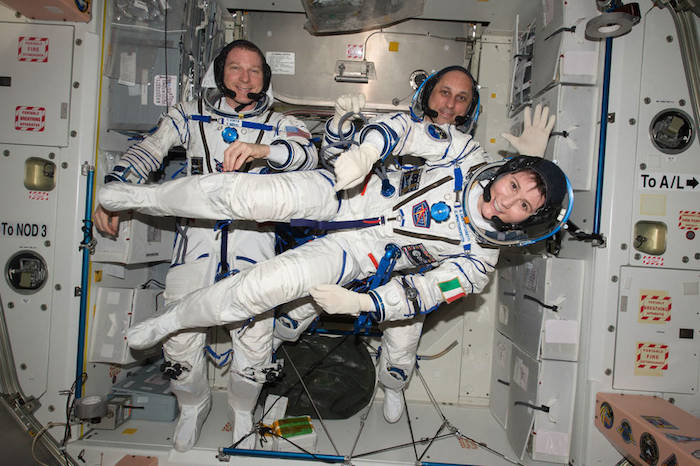
ISS043E174193 (05/06/2015) --- NASA astronaut Terry Virts (left) Commander of Expedition 43 on the International Space Station along with crewmates Russian cosmonaut Anton Shkaplerov (center) and ESA (European Space Agency) astronaut Samantha Cristoforetti on May 6, 2015 perform a checkout of their Russian Soyuz spacesuits in preparation for the journey back to Earth.
Credits: NASA
.
After more than six months of performing scientific research and technology demonstrations in space, three International Space Station crew members are scheduled to depart the orbiting laboratory Thursday, June 11. NASA Television will provide coverage of their station departure and return to Earth.
Coverage begins at 10:40 a.m. EDT Wednesday, June 10, when Expedition 43 Commander Terry Virts of NASA hands over command of the space station to cosmonaut Gennady Padalka of the Russian Federal Space Agency (Roscosmos).
At 6:20 a.m. the following day, Virts and Flight Engineers Samantha Cristoforetti of ESA (European Space Agency) and Anton Shkaplerov of Roscosmos will undock their Soyuz spacecraft from the space station and land in Kazakhstan at 9:43 a.m. (7:43 p.m. Kazakh time).
Their return wraps up 199 days in space, during which they traveled more than 84 million miles since their launch from the Baikonur Cosmodrome in Kazakhstan on Nov. 24. Their return date was delayed four weeks to allow Roscosmos to investigate the cause of the loss of the unpiloted Progress 59 cargo ship in late April.
NASA Television will broadcast departure and landing activities at the following times:
Wednesday, June 10
10:40 a.m. - Change of command ceremony in which Virts hands over station command to Padalka
Thursday, June 11
2:30 a.m. - Farewell and hatch closure coverage (hatch closure scheduled for 2:55 a.m.)
6 a.m. - Undocking coverage (undocking scheduled at 6:20 a.m.)
8:30 a.m. - Deorbit burn and landing coverage (deorbit burn scheduled at 8:51 a.m., with landing at 9:43 a.m.)
noon. - Video File of hatch closure, undocking and landing activities
10 p.m. - Video File of landing and post-landing activities and post-landing interviews with Virts and Cristoforetti in Kazakhstan
When the Virts, Shkaplerov and Cristoforetti land in Kazakhstan Thursday, Virts will have logged 212 days in space on two flights, the first of which was on space shuttle mission STS-130 in 2010. Shkaplerov will have spent 364 days in space on two flights, the first of which was on Expedition 29/30 in 2011. This was Cristoforetti’s first flight into space.
Expedition 44 formally begins aboard the station, under the command of Padalka, when the Soyuz undocks. He and crewmates Scott Kelly of NASA and Mikhail Kornienko of Roscosmos will operate the station until the arrival of NASA astronaut Kjell Lindgren, Russian cosmonaut Oleg Kononenko and Kimiya Yui of the Japan Aerospace Exploration Agency, who are scheduled to launch from Kazakhstan in July.
Kelly and Kornienko are spending one year in space, twice the typical mission duration, to provide researchers the opportunity to learn more about the medical, psychological and biomedical challenges faced by astronauts during long duration spaceflight.
Quelle: NASA
.
Update: 11.06.2015
.
Expedition 43 Crew Departs Space Station, Lands Safely in Kazakhstan
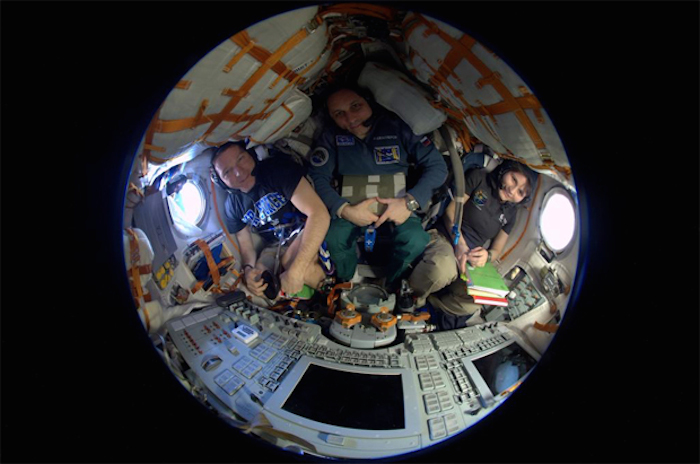
The Soyuz TMA-15M crew, reviewing entry procedures in their descent module before returning to Earth on Thursday. Left to right: NASA astronaut Terry Virts, spacecraft commander Anton Shkaplerov and European Space Agency astronaut Samantha Cristoforetti. NASA
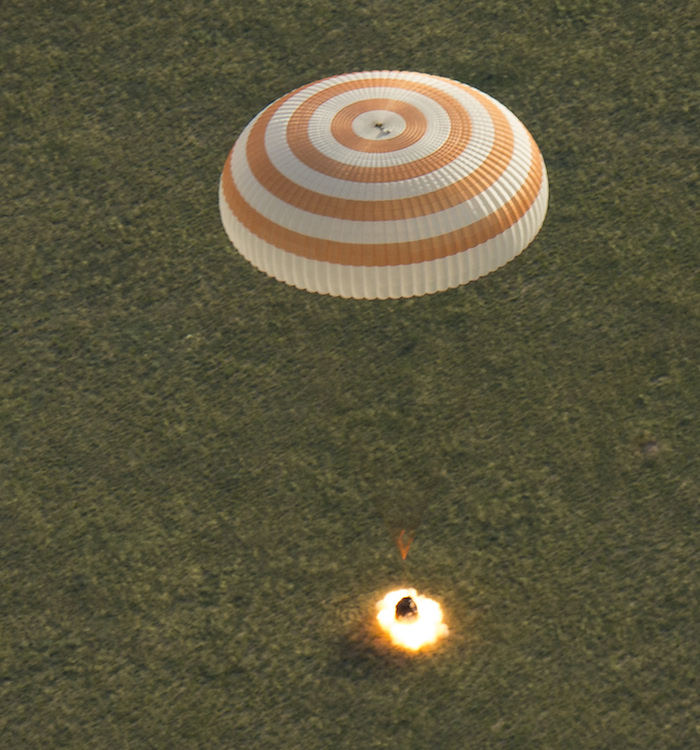
Ankunft von ISS-Crew-43 auf der Erde / Zhezkazgan, Kazakhstan
.

Expedition 43 Commander Terry Virts of NASA, Flight Engineers Anton Shkaplerov of the Russian Federal Space Agency (Roscosmos) and Samantha Cristoforetti of ESA (European Space Agency) touched down at 9:44 a.m. EDT (7:44 p.m., Kazakh time), southeast of the remote town of Dzhezkazgan in Kazakhstan.
Credits: NASA TV
.
Three crew members of the International Space Station (ISS) returned to Earth Thursday after a 199-day mission that included several spacewalks, technology demonstrations, and hundreds of scientific experiments spanning multiple disciplines, including human and plant biology.
Expedition 43 Commander Terry Virts of NASA, Flight Engineers Anton Shkaplerov of the Russian Federal Space Agency (Roscosmos) and Samantha Cristoforetti of ESA (European Space Agency) touched down at 9:44 a.m. EDT (7:44 p.m., Kazakh time), southeast of the remote town of Dzhezkazgan in Kazakhstan.
During their time aboard the orbiting laboratory, the crew members participated in a variety of research activities focusing on the effects of microgravity on cells, Earth observation, physical science, and biological and molecular science. Their research included the start of a one-year study into human health management over long-duration space travel with the March arrival of NASA astronaut Scott Kelly and Roscosmos cosmonaut Mikhail Kornienko – the One-Year Crew.
team members welcomed three cargo spacecraft during their stay on station. One Russian ISS Progress cargo vehicle docked to the station in February carrying tons of supplies, and Virts assisted with grapple and connection of two SpaceX Dragon deliveries in January and April -- the company's fifth and sixth NASA-contracted commercial resupply missions.
In preparation for the arrival of U.S. commercial crew vehicles, Virts ventured outside the station for three planned spacewalks to make adjustments for new International Docking Adapters (IDA) that can accommodate the spacecraft. The first IDA is scheduled to arrive on SpaceX’s seventh commercial resupply flight later this month.
The crew also had the opportunity to participate in the demonstration of new, cutting-edge technologies such as the Synthetic Muscle experiment, a test of a new polymer that contracts and expands similar to real muscle. This technology has the potential for future use on robots, enabling them to perform tasks that require considerable dexterity but are too dangerous to be performed by humans in space.
The crew engaged in a number of biological studies, including one investigation to better understand the risks of in-flight infections and another studying the effects microgravity has on bone health during long-duration spaceflight. The Micro-5 study used a small roundworm and a microbe that causes food poisoning in humans to study the risk of infectious diseases in space, which is critical for ensuring crew health, safety and performance during long-duration missions. The Osteo-4 study investigated bone loss in space, which has applications not only for astronauts on long-duration missions, but also for people on Earth affected by osteoporosis and other bone disorders.
The returning crew members will celebrate individual milestones in their space exploration careers. With the completion of his second mission, Virts now has spent 212 days in space. Shkaplerov, having completed his second long-duration mission on the station, has spent 364 days in space. Cristoforetti set a new record for single mission duration by a female astronaut with 199 days in space on her first flight, surpassing NASA astronaut Suni Williams’ previous record of 195 days as a flight engineer on Expeditions 14 and 15 from December 2006 to June 2007.
Expedition 44 now is operating the station with Roscosmos’ Gennady Padalka in command. Flight Engineers Scott Kelly of NASA and Mikhail Kornienko of Roscosmos, are continuing station research and operations until three new crewmates arrive. Kelly and Kornienko are on the first joint U.S.-Russian one-year mission, an important stepping stone on NASA’s journey to Mars.
NASA’s Kjell Lindgren, Roscosmos’ Oleg Kononenko and Japan Aerospace Exploration Agency astronaut Kimiya Yui are scheduled to launch from Kazakhstan in late July.
Quelle: NASA
.
Update: 12.06.2015
.
ISS crew successfully evacuated from descent capsule
The Mission Control Center specified that commander Shkaplerov was the first to be evacuated. Cristoforetti was the second and Virts the last one to be taken out
.
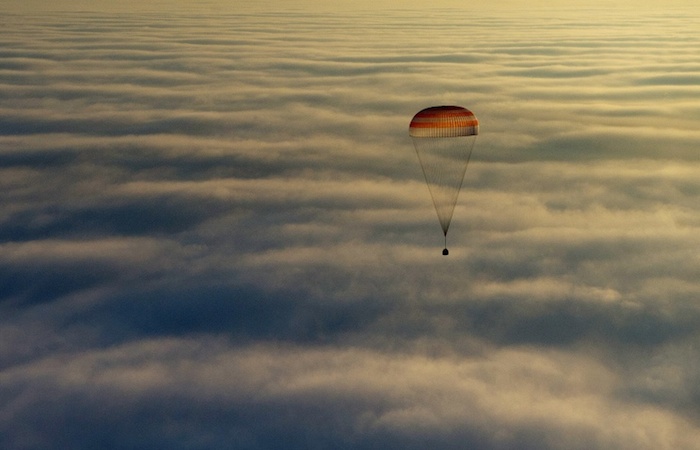
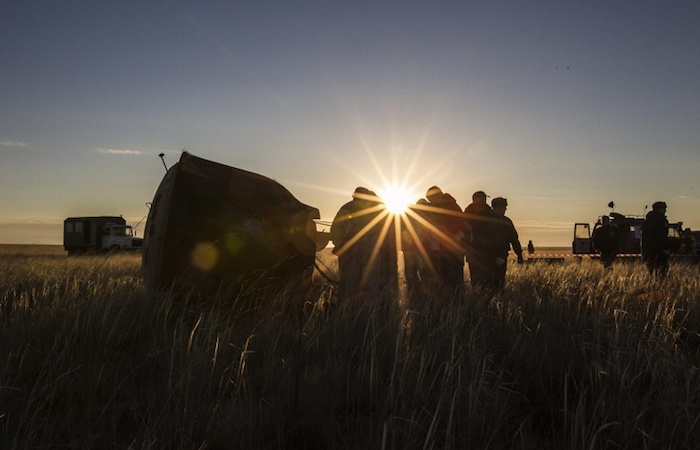
Members of a search and rescue group seen after finding a descent capsule in Kazakhstan in 2013© EPA/SHAMIL ZHUMATOV / POOL
KOROLYOV /Moscow Region/, June 11. /TASS/. Search and rescue groups have evacuated the astronauts, who returned to Earth from the International Space Station (ISS), from the descent capsule of the Soyuz TMA-15M spacecraft, the Moscow Region-based Mission Control Center said Thursday.
The descent capsule of the Soyuz TMA-15M manned spacecraft with three members of an international crew on board - Russian cosmonaut Anton Shkaplerov, American astronaut Terry Virts and European Space Agency astronaut Samantha Cristoforetti - landed at the estimated time in Kazakhstan.
The Mission Control Center specified that commander Shkaplerov was the first to be evacuated. Cristoforetti was the second and Virts the last one to be taken out.
The crew worked in orbit since late November 2014. The astronauts were to have returned May 14 but had to stay in orbit longer due to April’s accident involving the Progress M-27M spacecraft.
Russian cosmonauts Gennady Padalka and Mikhail Korniyenko, as well as NASA astronaut Scott Kelly remained on board the space station. The next manned spacecraft - Soyuz TMA-17M - will blast off toward the ISS July 24.
The Progress M-27M cargo spacecraft was launched on April 28 from the Baikonur space center on a Soyuz-2.1a carrier rocket. The rocket took the spacecraft to a higher orbit than required to dock with the ISS. After a few unsuccessful attempts to get control of the spacecraft, experts gave up the idea. The Progress was taking food, oxygen and other cargos to the ISS crew. It burned in dense atmosphere May 8.
Roscosmos concluded that the cause of the accident was "abnormal separation" of the Soyuz third stage and the Progress due to decompression of the rocket’s fuel tanks, caused by an unaccounted design property.
Quelle: TASS
After 199 Days in Orbit, Space Station Trio Comes Back Down to Earth
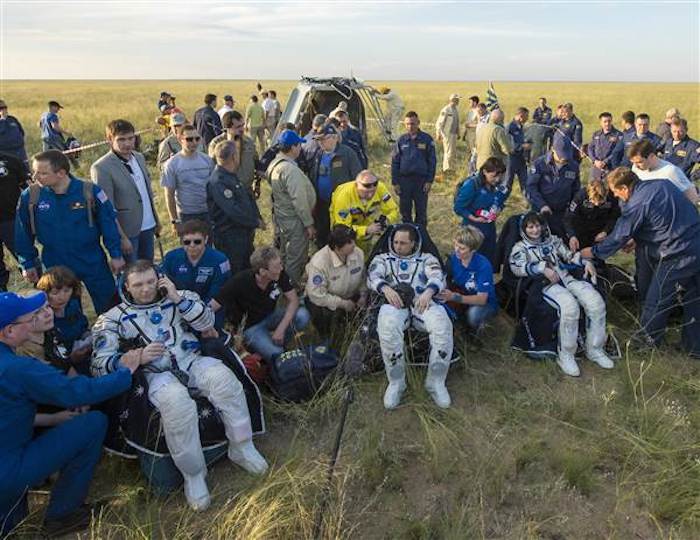
NASA's Terry Virts, Russia's Anton Shkaplerov and Italy's Samantha Cristoforetti sit in chairs outside their Soyuz spacecraft just minutes after landing in a remote area near the town of Zhezkazgan, Kazakhstan, on Thursday. Bill Ingalls / NASA
.
A NASA astronaut, a Russian cosmonaut and a record-setting Italian spaceflier left the International Space Station and landed back on Earth on Thursday after spending a longer-than-expected 199 days in orbit.
NASA's Terry Virts, Russia's Anton Shkaplerov and Italy's Samantha Cristoforetti sailed away in a Russian Soyuz space capsule right on time, at 6:20 a.m. ET, as part of a regular crew changeover. They touched down amid the steppes of Kazakhstan at 9:44 a.m. ET.
"It was a textbook homecoming," NASA commentator Rob Navias said.
After the landing, the three crew members were helped out of the capsule and set down in chairs to adjust to Earth's gravity. "I feel really good," Virts told the recovery team. "A cold water would be nice."
The spacefliers were taken to a medical tent for checkups, and within days they'll be back in their respective homes.
During the 199 days, Virts took part in three occasionally tense spacewalks to get the station ready for the arrival of U.S.-made spaceships a couple of years from now. The crew dealt with hundreds of scientific experiments, sipped the first espresso made in zero-G, and handled three robotic cargo deliveries — two by SpaceX Dragon capsules, and one by a Russian Progress craft.
The trio's return was delayed for nearly a month due to problems with a different Progress cargo ship in April. The craft was sent into a faulty orbit due to the failure of a Soyuz rocket and eventually burned up in Earth's atmosphere. The Russians didn't want to proceed with the station crew changeover until they finished investigating the mishap. Last week Russia launched its first Soyuz rocket since the failure.
The next three spacefliers are now scheduled to launch in another Soyuz capsule in late July.
The delay kept Cristoforetti in orbit long enough to set a space endurance record for women astronauts, surpassing the 195-day mark set by NASA's Sunita Williams in 2007. The record for male astronauts is 437.7 days, set by Soviet cosmonaut Valery Polyakov in 1995.
Three other astronauts remain on duty on the station: the outpost's new commander, Russian cosmonaut Gennady Padalka; and Russia's Mikhail Kornienko and NASA's Scott Kelly, who are in the midst of a nearly yearlong stay in orbit.
Quelle: BBC-News
4488 Views
